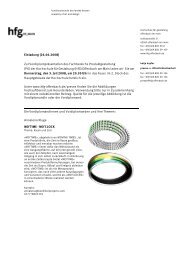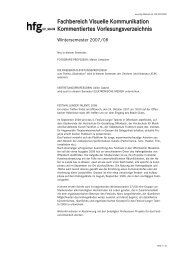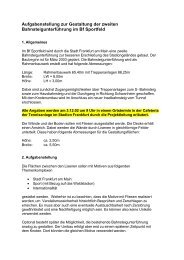User Manual
User Manual
User Manual
You also want an ePaper? Increase the reach of your titles
YUMPU automatically turns print PDFs into web optimized ePapers that Google loves.
Approval / (OK) button F<br />
This button steps through the three approval levels,<br />
thereby assigning an approval status to the image<br />
currently displayed (or selected) in the preview<br />
screen. (part of the Instant Approval Architecture system). Also<br />
acts as a confirmation button (OK button) for some types of menu<br />
operations, such as deleting images; indicated by a label beside the<br />
button on the preview screen.<br />
Busy-light G<br />
Flashes to indicate that the digital capture unit is performing an<br />
operation (such as saving a new capture). Although a new capture<br />
cannot be made while the light is flashing, focusing, aperture and<br />
shutter speed settings can all be changed.<br />
Red signifies a problem (an explanatory message will be displayed).<br />
Flash-card slot H<br />
Flash-card removal button I<br />
Flash-card slot cover J<br />
Safety catch K<br />
Used when removing the digital capture unit.<br />
General<br />
33<br />
CCD and IR filter L<br />
This is the light-sensitive element, which is positioned behind<br />
a permanently mounted IR filter. Always be very careful not to<br />
touch or scratch the surface of the filter when it is exposed and to<br />
replace the protective cover whenever the digital capture unit is<br />
not mounted on a camera.<br />
WARNING: never attempt to remove the glass filter—you will<br />
probably ruin the CCD if you do so.<br />
See Cleaning the CCD section for cleaning.<br />
Databus connectors M<br />
For digital communication with camera body.<br />
Flash sync input N<br />
Flash synch connector (protected behind a rubber cover) for when<br />
the digital capture unit is used with a view camera.<br />
Flash sync output O<br />
Flash synch connector (protected behind a rubber cover) for when<br />
the digital capture unit is used with a view camera.<br />
FireWire connector P<br />
Insert a FireWire 800 cable here to connect the digital capture unit<br />
to a computer or ImageBank-II.<br />
Using the menu on the H3D II is very similar to using a menu on a mobile/cell phone or similar. When<br />
you enter the menu (by pressing the MENU / button) you will be see an initial list:<br />
ISO<br />
White Bal.<br />
Media<br />
Browse<br />
.............<br />
Storage<br />
Settings<br />
It is advisable to initially quickly skim through the following section of the manual to<br />
build up a picture of the menu structure and its various sections.<br />
Note that some of the buttons have a double function while others remain single function.<br />
For example, the navigation button always takes you through the menu in the direction<br />
that the arrowhead illustrates. The zoom in/out buttons ( + and – ) though, for example,<br />
act as image enlargers and reducers as well as confirmation buttons, according to where<br />
you are on the menu.<br />
Time & Date settings on the digital capture unit (which are included with files and<br />
batch labels) are updated automatically through a FireWire/Phocus connection.<br />
These settings are retained for about two consecutive weeks by a small rechargeable<br />
cell that is automatically recharged by the main battery or Firewire with regular use.<br />
If problems occur, charge the cell by leaving the digital capture unit turned ON for<br />
around 12 hours.



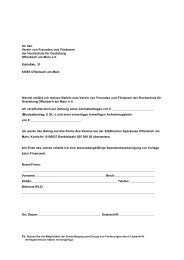
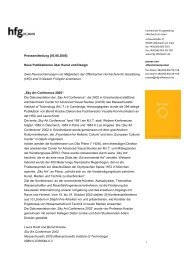


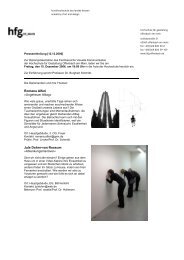

![Einladung [07.02.2006] - Hochschule für Gestaltung Offenbach am ...](https://img.yumpu.com/13375413/1/184x260/einladung-07022006-hochschule-fur-gestaltung-offenbach-am-.jpg?quality=85)

